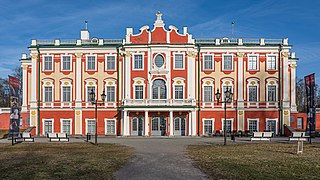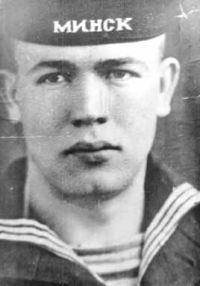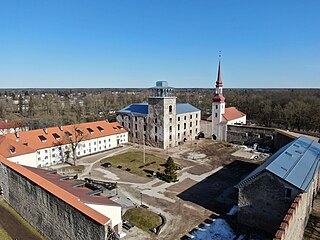
Tallinn is the capital and most populous city of Estonia. Situated on a bay in north Estonia, on the shore of the Gulf of Finland of the Baltic Sea, Tallinn has a population of about 457,000 and administratively lies in the Harju maakond (county). Tallinn is the main governmental, financial, industrial, and cultural centre of Estonia. It is located 187 km (116 mi) northwest of the country's second largest city, Tartu; however, only 80 km (50 mi) south of Helsinki, Finland, also 320 km (200 mi) west of Saint Petersburg, Russia, 300 km (190 mi) north of Riga, Latvia, and 380 km (240 mi) east of Stockholm, Sweden. From the 13th century until the first half of the 20th century, Tallinn was known in most of the world by variants of its other historical name Reval.

Soviet-era statues are statuary art that figured prominently in the art of the Soviet Union. Typically made in the style of Socialist Realism, they frequently depicted significant state and party leaders, such as Joseph Stalin and Vladimir Lenin.

Jõgeva is a small town in Estonia with a population of around 5000 people. It is the capital of Jõgeva Parish and Jõgeva County.

The Kumu Art Museum is an art museum in Tallinn, Estonia. It is one of the largest museums in Estonia and one of the largest art museums in Northern Europe. It is one of the five branches of the Art Museum of Estonia, housing its main offices.

The Raeapteek is a pharmacy in the center of Tallinn, Estonia.

The following is an alphabetical list of articles related to the Republic of Estonia.
This article covers the architecture of Estonia.

The Estonian Maritime Museum is located in the Fat Margaret tower in the old town of Tallinn. The museum presents the history of ships and navigation in Estonia and related to Estonia. Other parts of the Maritime Museum are the mine museum and the Seaplane Harbour museum where ships are presented. The museum claims to be one of the largest museums in Estonia and the most popular.

Maarjamäe is a subdistrict in the district of Pirita, Tallinn, the capital of Estonia. It is bordered by Pirita and Kose to the north, Lasnamäe to the south, Kadriorg to the southwest and the Bay of Tallinn to the west. As of 2022, it has a population of 2,412.

Kadriorg Palace is an 18th-century Petrine Baroque palace in Kadriorg, Tallinn, the capital of Estonia. Both the Estonian and the German name for the palace means "Catherine's valley". It was built in 1718–1725 to Nicola Michetti's designs by Gaetano Chiaveri and Mikhail Zemtsov. The palace currently houses the Kadriorg Art Museum, a branch of the Art Museum of Estonia, displaying foreign art from the 16th to 20th centuries. The building of the Kumu branch of the museum, showing Estonian art from the 18th century onwards is located nearby in the Kadriorg Park.

Kirna is a village in Türi Parish, Järva County in central Estonia.

Järlepa is a village in Rapla Parish, Rapla County, Estonia. It has an area of 10.02 km2 (3.87 sq mi) and a population of 206.

Yevgeny Alexandrovich Nikonov was a Russian sailor during the Soviet defense of Estonia in 1941. He is a holder of the Hero of the Soviet Union, the Soviet Union's highest award.

Põltsamaa Castle, also Põltsamaa Order Castle,, is a castle in Põltsamaa, Jõgeva County, in eastern Estonia.
The Estonian Institute of Historical Memory is a non-governmental foundation that focuses on the investigation of war crimes and human rights violations committed by totalitarian regimes and research of totalitarian ideologies that created such regimes. The Institute aims to give the general public a comprehensive, objective and international overview of human rights violations and crimes committed by totalitarian regimes both in Estonia and abroad.

Maiasmokk is a historical café in Tallinn, the capital of Estonia. In its current form it dates back to 1864, making it the oldest operational café in Estonia. The premises also contain a museum about the history and uses of marzipan. It is currently owned by the Kalev company.

The Estonian Health Museum is a health museum in Tallinn, Estonia. The museum collects, exhibits, and analyzes objects related to healthcare in Estonia.

Maarjamäe Palace is a building in Maarjamäe, Tallinn. The palace is located on the area of earlier Maarjamäe summer manor, being its main building. Nowadays, the palace is used by Estonian History Museum.

Ants Kaljurand popularly known as Terrifying Ants,, was an Estonian Nazi collaborator, anti-communist, and forest brother during and after World War II.

Hannes Walter was an Estonian war historian.

























